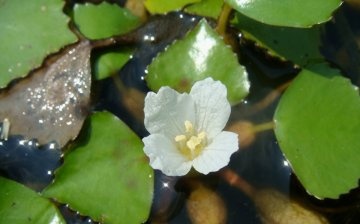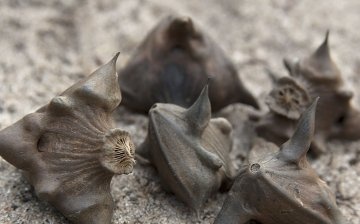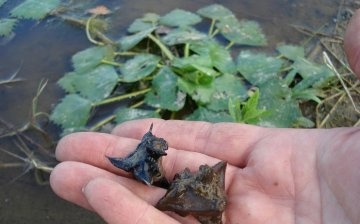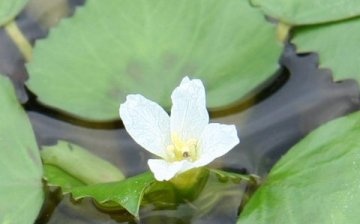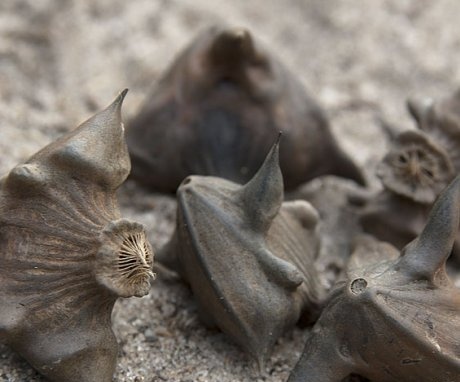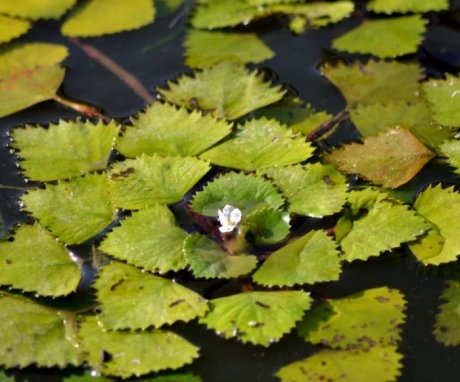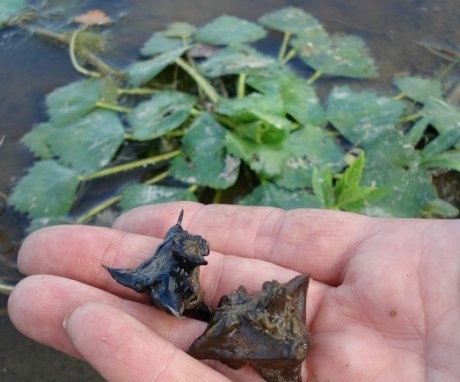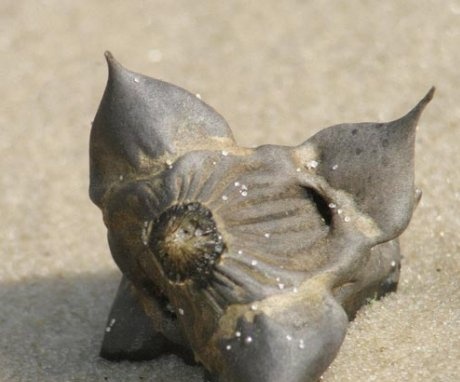Rogulnik - a beautiful decoration for a pond in the garden
Rogulnik or chilim is a very plant that surprises with its life cycle. It starts out amazing in shape walnut and grows into a beautiful above-water rosette, spreading leaves on the water surface of a fresh reservoir.
The bagel will decorate any water source where there are no strong currents. Nowadays, water walnut is rarely found anywhere - here and there in Siberia and the Far East. However, the curiosity can be grown in an aquarium or home pond. Chilim will become the pride of the owners, since this plant is already listed in the Red Book. The grower will learn how to grow a roguelnik in a lake or pond from this helpful garden guide.
Content:
- Description of the flyer
- Growing conditions
- Reproduction and planting of a flyer
- Walnut care
- Application of water walnut
Description of the flyer
The plant is a tall stem with underwater and emergent leaves, belongs to the family of rogulaceae. The nut has several interesting names, formed due to the region of growth and culture of the people who inhabited it - "chilim", "devil's nut", "water chestnut" and "dragon".
Features of the structure of the flyer:
- They have a linear shape, the latter are located above the water and have a diamond shape.
- The leaves on the surface are very similar to greens. birch.
- In summer, the resulting rosette begins to bloom with white or pinkish inflorescences. They emerge only in the morning and in the evening, in the afternoon the inflorescences are under water.
- The leaves of the bunny take on a beautiful brownish-brown hue in the fall.
- Chilim fruits are very similar to small dragon heads - they have 4 horns and an ornate body.
For their beauty and unusualness, chilim fruits have become famous all over the world. They are often used as decorative elements in compositions. The fruits of the plant have such an unusual shape for a reason. The "horns" of the walnut are intended for migration from one body of water to another. Whenever an animal enters the water, the nut clings to its fur and travels on its "transport" to the next body of water. This is how the plant populations grew. However, due to the massive destruction of wild animals, the walnut habitat has sharply decreased. Now the outlandish fruit is very rare.
Since the plant practically disappears due to its massive use in the recent past, it is listed in the Red Book.
Rogulnik has several species and is subdivided into annuals and perennials. For growing chillim at home, they use a champlet-leaved species, Japanese, Manchurian, Russian or Siberian. The plant prefers warm waters, fresh, without cold and fast underwater currents. It should be a lake or stagnant pond. In order to successfully grow a rare plant, you will have to work hard to create conditions for a roguer.
Growing conditions
Rogulnik likes warm waters, with diffused sunlight. The water temperature is at least 23 °. Sunlight must constantly illuminate the water surface. Chilim prefers standing fresh water. The plant will not grow in a muddy pond. The bottom must be clean and free of foreign matter.
It will also not grow in small containers, the rogler prefers a roomy and deep container.
The height of the stem of the nut can reach 3-4 m. It is impractical to grow the plant in small aquariums, since chillim is mainly bred for the sake of medicinal fruits. You can collect them in large quantities only from several plants, and not from one.
Much attention should be paid to the substrate for the roguer:
- The reservoir is filled with silt, greasy clay and sand.
- It is necessary to grow the plant only in pure silt without impurities.
- Do not take the substrate from the first lake that comes across, try to find out if the reservoir is not polluted by industrial waste.
- The success of growing a nut will depend on the quality of the substrate.
Of course, in cold regions, a roguelike will not grow in open water. In this case, you should think about a large home aquarium for walnut... Otherwise, the plant does not require any special conditions other than those indicated.
Reproduction and planting of a flyer
The water nut multiplies seeds... The fruits are stored in canvas bags or wooden boxes. The nut retains its germination for several years. Germinates fruit in water in compliance with all conditions - temperature and lighting.
Recommendations for planting flyer seeds:
- The seeds are placed in soil at the bottom of the reservoir for 3 weeks. During this period, a sprout should appear. The root rises to the top and in an arc again descends into the ground. The nut floats to the surface. A socket is formed from it.
- Seeds are planted in spring, as it is during this period that the plant wakes up and begins its life cycle.
- If you plan to grow the flyer in an aquarium, and not in a pond, organize a special flowerpot for it. Fill a container with greasy clay, sand, and clean silt. The nut will develop in this container. The water should be fresh, warm - 20 ° -25 °.
Lighting is important. Especially when the plant is grown at home. Direct the light onto the aquarium, it should illuminate the container for at least 10 hours. The walnut is usually placed in the background of the reservoir, next to the walls, in the corner. During the growing season, the plant "walks", that is, it must be able to move.
Providing all conditions and following the rules landing, the nut will grow strong and healthy. Chillim must be looked after, despite the fact that it develops well on its own.
Walnut care
After planting a nut in an aquarium, keep the water clear. It is advisable to change it in volume by about a quarter of the total displacement. The soil should also be free from contamination. The main requirement for the successful development of the nut is the maintenance of the temperature regime. Supercooled water contributes to the death of the plant. Lack of lighting will also lead to stunted growth and fruit formation. If the flyer does not have enough light, he eloquently shows this - the leaves do not spread over the water, but stretch upward, towards the sun.
If the plant is grown in a body of water, care must be taken to avoid the cultivation of gastropods.
The main "enemies" of the nut are coils and pond snails. They actively gnaw the greens of the plant. If a lot of them are divorced, then the roguer will most likely die. The stem and roots will be eaten by the shellfish. Small freshwater inhabitants will not cause significant harm, but it is worth protecting from large chillim.
In autumn, when the nut is fully ripe, the leaves and stem of the chilim die off. This moment should not be missed. Nuts need to be collected, dried and removed on time. storage in a warm, dark place or use them for their intended purpose - for cooking or medical purposes. The aquarium or pond is cleaned. The next planting of seeds is carried out in the spring, as is laid down in the biorhythm of the plant. Some chillim growers store the fruits in water, as they do in nature. This is the best option if the nuts are planned to be planted for the next harvest.
Application of water walnut
The nut is known for its beneficial composition for the body, which is often equated with cereals.That is, before the fruit was used to make flour, bread, flat cakes and other goodies were baked from it. In Tibet, cakes are baked from this flour or simply mixed with water and eaten. The fruits are also eaten raw, they are very similar in taste to chestnuts. It is added to salads, canned food, lecho and soups. One nut contains up to 200 calories in terms of nutritional value.
In addition to its use in cooking, chillim is widely used in folk and traditional medicine:
- In Asian countries, they are treated for atherosclerosis, kidney disease, impotence.
- The use of walnut strengthens the immune system and has antispasmodic, choleretic, tonic and strengthening properties.
- They use not only the fruits of the roguelite, but also the leaves and stems. A decoction is made from greens and rinsed with it. It is an excellent remedy for alopecia.
- Chillim juice is used to treat snake and other insect bites.
- Decoctions are used for colds, since the plant has an antiviral effect.
- The simple use of raw nuts, 3-4 things a day, will relieve many ailments, strengthen the immune system and calm the nerves - it has a sedative effect.
Many growers use the fruit as a decorative element in flower arrangements. If you cover the walnut with special paint, you get an unusual souvenir. The fruits are used for flower arrangement and in landscape design... Ponds and ponds are decorated with it. Moreover, the plant is very rare - it becomes the real pride of the owner.
Rogulnik is an amazing plant with many benefits. Its cultivation will bring not only benefits for the whole family, but also a real aesthetic pleasure!
More information can be found in the video:



